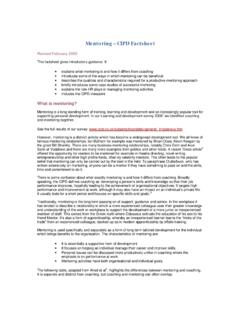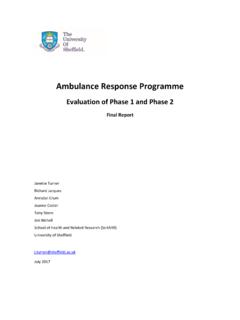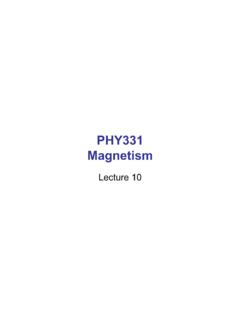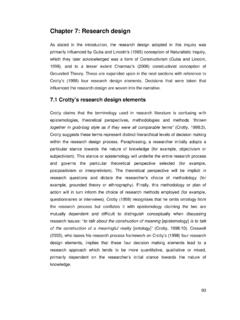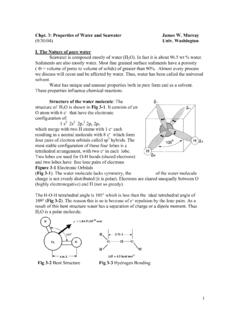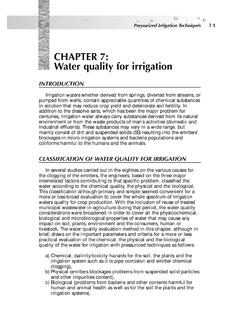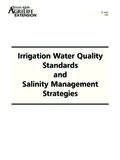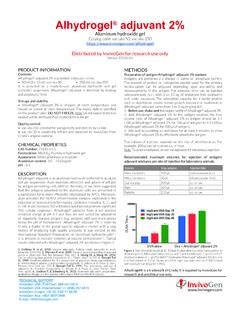Transcription of Protocols and tips in protein purification
1 Protocols and tips in protein purification or How to purify protein in one day Second edition 2018 Department of Molecular Biology & Biotechnology 2 3 Contents I. Introduction 7 II. General sequence of protein purification procedures Preparation of equipment and reagents Preparation and use of stock solutions Chromatography system Preparation of chromatographic columns Preparation of crude extract (cell free extract or soluble proteins fraction) Pre chromatographic steps Chromatographic steps Sequence of operations during IEC and HIC Ion exchange chromatography (IEC) Hydrophobic interaction chromatography (HIC) Gel filtration (SEC)
2 Affinity chromatography purification of His-tagged proteins purification of GST-tagged proteins purification of MBP-tagged proteins Low affinity chromatography 9 9 10 11 13 17 18 18 18 19 21 22 24 25 26 26 26 III. Common sense strategy in protein purification General principles and tips in common sense strategy Algorithm for development of purification protocol for soluble over expressed protein Brief scheme of purification of soluble protein Timing for refined purification protocol of soluble over -expressed protein DNA-binding proteins 27 27 29 36 37 38 IV. Protocols 1.
3 Preparation of the stock solutions 2. Quick and effective cell disruption and preparation of the cell free extract 3. Protamin sulphate (PS) treatment 4. Analytical ammonium sulphate cut (AM cut) 5. Preparative ammonium sulphate cut 6. Precipitation of proteins by ammonium sulphate 7. Recovery of protein from the ammonium sulphate precipitate 8. Analysis of solubility of expression 9. Analysis of expression for low expressed His tagged protein 10. Bio-Rad protein assay Sveta s easy protocol 11. protocol for accurate determination of concentration of pure protein 12. Calibration plot for gel filtration column 13. Ni-chelating cartridges : cleaning and recharging 14.
4 SDS PAGE Sveta s easy protocol 15. DTNB reaction 16. Refolding protocol 41 41 42 43 43 43 44 44 45 46 47 47 48 48 49 50 50 4 V. Charts and Tables Ammonium sulphate Sugar refractometer NaCl-Sugar refractometer Calibration plot for Hi-load Superdex 200 column Calibration plot at various salt concentrations for Superdex200 GL column Ammonium sulphate table Properties of amino acids 51 53 54 55 56 57 58 VI. Appendix 1 of protein concentration to concentrate proteins to store proteins to estimate purity of a protein preparation VII.
5 Appendix 2 1. Prepare your solutions right! 2. Gel filtration Separation by molecule s size Calibration plot Main reasons for abnormal mobility of some proteins during gel filtration 3. Time saving tips 4. Golden rules in protein purification VIII. Show cases 1. Two step purification protocol and a lesson to learn (BPSL 1549 (BLF1)) 2. It is easy with the coloured proteins! Single-domain haemoglobin cgb from Campylobacter jejuni Flavohemoprotein HMP from Escherichia coli 3. Almost typical three step purification (Glutamate Dehydrogenase from Clostridium symbiosum) 4. Monitoring purification by enzyme activity (Glutamate Dehydrogenase from Clostridium symbiosum) 5.
6 Power and failure of dye pseudo affinity chromatography Phenylalanine Dehydrogenase from Nocardia sp. Glutamate Dehydrogenase from Clostridium symbiosum 6. DNA binding proteins Typical Heparin protocol : RuvC from phage bIL67 Playing with solubility: LrpC from Bacillus subtilis Heparin and solubility: FrmR from Escherichia coli Real power of Heparin: Human FEN In need of nuclease treatment: SfsA 7. Tagged proteins Proper use of a His-tag: Human protein PARP1 expressed in Removable tag: SAG19 Cleaver use of tag: TssA 8. Special cases Phosphoglycerate Kinase (PGK) from Escherichia coli Low affinity chromatography: BPSL1958 BacM from Myxococcus Xanthus Perfect purity.
7 IGPD from Arabidopsis thaliana 59 59 64 67 68 69 69 70 70 71 72 73 74 75 75 79 79 81 85 88 91 91 97 102 102 104 105 108 111 116 116 118 121 124 124 127 130 134 5 Abbreviations AA acrylamide APMSF 4-Amidinobenzylsulfonyl fluoride hydrochloride AS ammonium sulphate CBV column bed volume CE crude extract CFE cell free extract CM carboxymethyl DEAE diethylaminoethyl DTNB Dithionitrobenzole DTT dithiothreitol EDTA ethylenediaminetetraacetic acid FF fast flow HEPES N-(2-hydroxyethyl)piperazine-N'-(2-ethan esulfonic acid) HIC hydrophobic interaction chromatography IEC ion exchange chromatography MES 2-morpholinoethanesulfonic acid MW molecular weight MWCO molecular weight cut off PBS phosphate saline buffer PS protamine sulphate PSA ammonium persulphate PAGE polyacrylamide gel electrophoresis Q quaternary ammonium S methyl sulphonate SDS sodium dodecyl sulphate SEC size exclusion chromatography or gel filtration SP sulphopropyl TEMED N,N,N',N' tetramethylethylenediamine TP target protein UV ultraviolet Contact details Dr.
8 Svetlana Sedelnikova Department of Molecular Biology and Biotechnology The University of Sheffield Sheffield S10 2TN Please, contact me by e-mail All your comments and questions are very welcome 6 With greatest respect and gratitude to my teachers Prof. Alexander Sergeevich Spirin and Prof. Marina Borisovna Garber and people of Institute of protein Research, Pushchino and also to my employers Prof. David W. Rice and Department of Molecular Biology and Biotechnology of the University of Sheffield 7 I. Introduction Why do we need to purify protein in one day? After 25 years and 360 proteins it has become clear to me that for some proteins even one extra day under conditions normally used for protein purification can detrimentally affect their activity and crystallisation ability. Whilst the majority of proteins can survive long purification and can be kept and stored at 4 C for days and even weeks with little loss in activity, it does them no harm to be purified in one day either.
9 To achieve the goal of complete protein purification in one day you should move fast and choose appropriate Protocols , avoiding long procedures such as dialysis, long centrifugations and slow chromatography. Below are some Protocols and tips which help me to achieve this goal. My approach is based on classical combination of ion-exchange, hydrophobic and size-exclusion chromatography for natively (no tags) over-expressed proteins. Nowadays the high throughput approach dictates increasing use of tags in protein purification and sometimes classical methods are considered to be defunct. This is not the case. The most justified use of tags is for difficult expressions, such as expression of eukaryotic proteins in , expression of the domains of the proteins, toxic proteins, in the cases when tags help polypeptide chains to fold, in the cases when correct fold occurs only occasionally and so expression yield is hardly detectable.
10 In such the cases tagged proteins often cannot be purified to the desirable purity by using just one tag affinity chromatography, so more purification steps are required anyway. We also have to remember that tag as well as being often useful in some cases it may be an obstacle that prevents correct proteins folding. I consider the recent trend to do all expressions in a tagged form is misleading . For most of enzymes and similar cytoplasmic proteins the chance to be successfully expressed is greater in the absence of the tag. My recent experience also revealed that if the fusion protein or the tag has to be removed from the target protein you may face a great problem either with protease underperforming or unspecific proteolysis leading to damage of the target protein . In this second edition I have included my recent experience with purification of the tagged proteins. Please note that this brochure is not a complete guide to protein purification and you should still read serious books on the theory of chromatography to become familiar with the subject.

